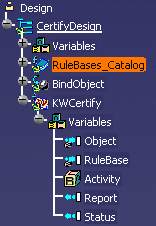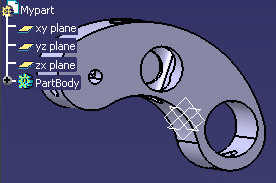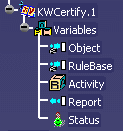 |
-
From the Start>Knowledgeware menu, access the
Business Process Knowledge Template workbench.
-
Create the Design technological type.
|
|
|
|
|
|
 |
At this stage of the scenario, the BKT tree looks
like the one opposite. |
 |
-
Click the Design type and the Sequence
Combination behavior icon ( )
to create a combination of behaviors. )
to create a combination of behaviors.
-
Double-click SequentialCombination in the Behaviors View
and double-click Design in the Behaviors tab. The Sequential Combination
is displayed in the Behaviors tab.
-
Double-click the Sequential Combination. The Sequential
Combination dialog box is displayed. In the name field, enter
CertifyDesign. Click OK when done.
-
Click the SequentialCombination combination and click the
FilterCatalog icon ( ).
The FilterCatalog behavior is displayed ).
The FilterCatalog behavior is displayed
-
Double-click the FilterCatalog node. The Filter Catalog
editor is displayed.
-
Click the Certify Design combination and click the
Bind Object behavior icon ( ). ).
-
Double-click the Bind Object node. The Bind Object editor
is displayed.
|
|

|
".." indicates that the bind must be
performed on the upper level. In the current context, you go up 3
levels to reach the root product. |
|
|
-
Click the Certify Design combination and click the
Knowledge Certify behavior icon ( ).
KWCertify is displayed in the Behaviors tab. ).
KWCertify is displayed in the Behaviors tab.
-
Double-click the KWCertify node. The KWCertify editor is
displayed.
|
|
|
|
|
|
 |
At this stage of the scenario, the behaviors tree
looks like the one opposite. |
 |
-
Save the .CATfct file. Click
here to access the
created .CATfct file.
-
Click the Generate Applicative Workbench icon
( )
to generate a user workbench. Enter the name of the workbench,
Applying_rulebase in this example, select Part from the
scrolling list, and click OK to validate. The generated
workbench opens. )
to generate a user workbench. Enter the name of the workbench,
Applying_rulebase in this example, select Part from the
scrolling list, and click OK to validate. The generated
workbench opens.
-
From the Tools>Options...>Knowledgeware>Business
Process Knowledge Template menu, select All Users
from the Access Rights scrolling list and click OK
to work in a User environment.
|
-
Open the
bktCatalogImport.CATPart file in the user workbench. The following
picture is displayed.

-
Click the root of the specification tree, the
 icon, the root of the
specification tree, and click the Design icon to type the part. icon, the root of the
specification tree, and click the Design icon to type the part.
-
Right-click Design (MyPart) and select
Design(MyPart) object>CertifyDesign. The Catalog browser is
displayed.
|
-
Double-click ComponentFamily.2 and RuleonHole. The check
contained in the rulebase is launched and performs a check of the holes.
A report is launched displaying the result of the check.
-
Update the Part.

| |
|
|
 |
- Note that the Status of the check is indicated in the
specification tree in the form of a green/red light. If the check
runs correctly, the light is green, if not it is red.
- Note that the report can be accessed by double-clicking the
Report node in the specification tree.
|
 |
|
![]()